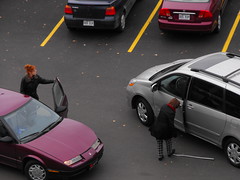If you know enough about automotive safety to have your car insured in the first place, then you know better than to drive around without something to take photographs with. These days, most cell phones come with a camera, so you might not need to keep a disposable camera in your emergency kit, but you definitely need something to take photos with.

Not everyone knows how to properly photograph their car following an accident, though.
Most drivers think it’s enough to grab a quick shot of the damage. The fact is, though, that a close up of a dent could be a photograph of any car that’s the same color as yours. When you photograph an accident scene, you need more coverage than Alfred Hitchcock on a movie set.
- Start with wide shots. Step back a bit (obviously not back into traffic or anything), and take a few shots of the whole scene from a few angles. This will establish the basic geography of an accident scene.
- You should also photograph the whole car. You’re probably not going to notice all of the damage done right away, and when you spot those damages later on, the last thing you want is to be left without photographic evidence, so photograph the entire car just in case something comes up later.
- Photograph the other driver’s car, too. This ensures that you have evidence of the whole scene, that the other driver isn’t going to be stretching the truth in civil claims court or to the insurance companies.
- Photograph all of the skid marks and other damages done to the road and the area in which the accident took place. Skid marks can indicate that you did, in fact, use your brakes, and combined with other visual evidence, can help you to build your case.
Unless you have another car following you around with a video camera all day, the only way to tell the story of what happened is through photographic evidence of the results of the accident. With digital photography, you can take hundreds of pictures without running out of film, so there’s no reason not to take as many pictures as you possibly can.
It’s also a good idea to keep “before” photos around. It’s easy for the other driver to insist that you already had a fender embedded in your windshield before he smashed into you, so anything that you can use to prove that the damages were caused by the accident in question will be useful in filing a claim.





